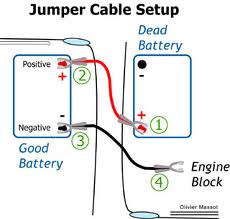If you suspect the battery maybe flat then follow the instructions below.
No matter what kind of car you drive, there may come a time when you need to jump start your car or somebody else's car.
Things to look for when suspecting a flat battery:
Check the headlights. Do they come on? Are they dim or bright? (Note that in some cars you will need to turn the ignition on to test the headlights). If they are dim, it's likely your battery is the culprit. If your headlights are bright, you do not have a dead battery and a jump start will not help.
Put the key in the ignition and see whether your dashboard lights up as usual. Test the stereo. In most cases, even with a low battery you should see some dashboard lights and get some sound out of the stereo. If you do not get a flicker out of your dashboard, you may have a problem with your ignition switch.
Try to start the car. Does it turn over very slowly, or does it crank quickly? If it cranks quickly, you do not have a dead battery and a jump start will not help. If it cranks slowly, or not at all, you probably have a dead battery.
What you'll NEED to jump start a car:
1. Jumper cables with thick wires and clean, rust-free clamps.
2. Another car with a fully-charged battery the same voltage as your own battery.
Check the vehicle handbook before using jump leads. All include general advice on jump starting but some include model specific procedures. If this is the case you must follow the manufacturer's procedure rather than the steps described below.
Learning how to jump start a car is fairly simple as long as you follow several important safety instructions.
Safety rules
Keep metal objects away from the top of the battery – rings, watch straps, hand tools, clips or stray wires just brushing a battery post can cause a massive spark, possibly exploding the battery and releasing the acid.
Don't attempt to jump-start a battery that is leaking or looks damaged – an explosion could result.
Avoid smoking or naked flames – batteries give off flammable gases and an explosion could result.
Keep hands well away and avoid loose fitting clothing, particularly scarves or neckties – with the engine running it's easy to get caught-up and seriously injured on moving parts like pulleys or belts.
Jump leads must be in good condition – damaged conductors or clamps can result in overheating and the possibility of fire.
Before connecting any leads make sure the vehicles are the same voltage and that they're parked with their handbrakes on and ignition off. The vehicles must not touch as this can cause sparks or an explosion.
Ensure that when you are connecting and removing the jump leads, they do not touch each other and do not come into contact with any moving parts on either engine. Most quality jump leads have the clamps coated with plastic so there is less chance of the metal parts touching parts of the car or engine. This is something to consider when buying your jump leads.
Step by step
1. Pull a car with a charged battery next to the car with the dead battery, situating the two batteries as close together as you can without allowing the two cars to touch.
2. Turn off both engines, turn off all electrical equipment and put both cars in neutral (or park in an Automatic), engage the handbrakes and open the bonnets

3. Connect the red-handled/positive jumper cable clamp to the positive terminal, (the one with the plus sign) of the dead battery.
4. Attach the other red-handled/positive jumper cable clamp to the positive terminal of the charged (good) battery.
5. Attach the neighboring black/negative cable to negative terminal (the one with the minus sign) of the car with the charged, (good battery).
6. Connect the other end of the black/negative cable to a good solid SHINY, NON PAINTED metal part of the engine on the dead car. Usually a giant shiny nut on the engine block will do. A painted, dirty, or oily nut will not work. You usually want to avoid placing the black cable directly on the dead battery to minimize the chance for explosions. On this step you'll get a normal spark as you connect the ground and complete the circuit.
7. Start the car with the good battery and then try and start the car that has the dead battery.
8. Once the dead car is running, leave both running at a fast idle for ten minutes. remove the clamps one at a time in reverse order.
Allow the jump-started car to run for 15 minutes in order to charge the battery. It will charge whether driving or idling.
If the jump leads get hot, then avoid a possible fire by switching off both engines and allowing the leads to cool.Be careful not to touch the clips against each other or against the car bodywork.
